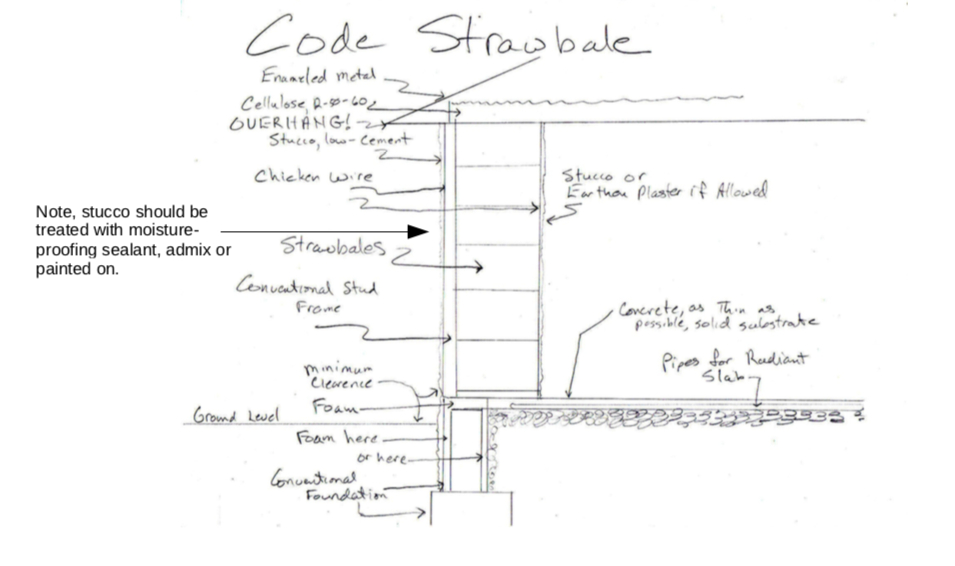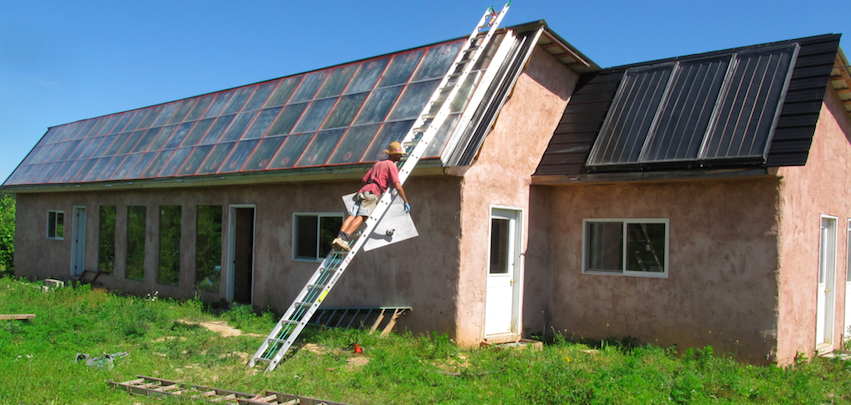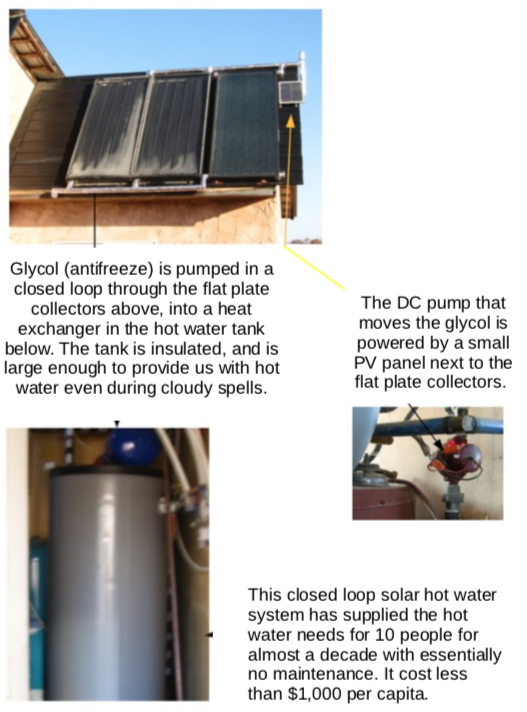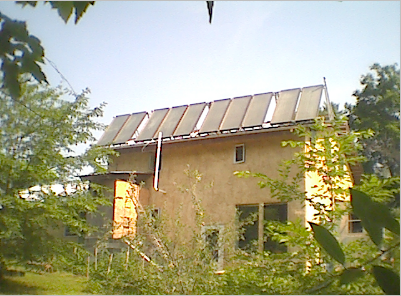In any climate other than tropical, the largest domestic energy use is for space heating and water heating. For these applications, solar thermal is the most sustainable, durable, low-maintenance energy source available. A well designed solar thermal system is a critical foundation for an effective (non-tropical) DC Microgrid.
The information and resources below are most useful in a temperate climate with an average of at least 4.5 kwH/sq meter/day of solar radiation (see this map).
What is Solar Thermal?
Solar thermal is an energy system where solar radiation is used directly as heat, instead of being converted to electricity, as is done with photovoltaics (PV). Solar thermal is a well established technology. Passive solar thermal has been around for millennia, while active solar thermal systems have been in common use in some parts of the world since the 50s.
Solar thermal may be passive or active. Passive solar, used mainly for space heating, means designing a building for maximum solar exposure through the windows in winter. In winter the sun angle is low in the southern sky, so windows on south facing walls will allow more sunshine into the living space and warm the building. In the summer, the sun is directly overhead, so south facing windows are not a liability. It’s a simple concept, and you don’t need to overthink it. Just put plenty of windows on the south facing side, less on the north, east and west. Also, keep in mind that in a well-insulated modern building, windows and doors are your biggest sources of heat loss at night. We recommend using tight-fitting, insulated thermal curtains, lowered at night and raised during the day, over any large windows to keep your heat losses to a minimum. Our favorite is Kume style thermal curtains, which use wooden battens to maintain a tight seal between the curtain and the window well.
In active solar thermal systems, heat is collected and transferred into a storage medium, where it may be accessed when the sun isn’t shining. These systems use a heat transfer material, either air or fluid, to move the heat from the collector and into storage. While these systems take skill to design and build, they are incredibly useful in cold and temperate climates. With these systems, cooperative use is essential in making services affordable. For example, a quality solar hot water system that provides services for three families can be built for roughly the same cost as a system that services one family. Similarly, a large mass of thermal storage relative to the length of perimeter wall is critical for effective solar heating. That is a complicated way of saying that active solar heating systems work better on large buildings than they do on tiny houses.
Solar thermal systems require super insulation to be an effective energy source. The temperatures that solar thermal systems can achieve are modest (compared to fossil fuel or wood heat) and obviously can’t be turned on and off at will. Generally speaking, the amount of insulation required by code is not sufficient to hold onto solar heat. You are wasting your time and resources building a complicated solar thermal system in a badly insulated building. Insulate your building first, then think about adding solar (either thermal or PV). Read on for more information about insulating with straw bales and other low-cost materials.
Solar thermal vs. Photovoltaics (PV)
Solar thermal and photovoltaics are very different systems, each with their own strengths and weaknesses. Both have an important function in a DC Microgrid. Generally speaking, when making solar energy into heat, we recommend using solar thermal instead of photovoltaics. One exception to this is cooking.
Strengths of solar thermal compared to PV
-Storage is generally more effective with thermal than PV. This is because thermal storage is much much cheaper, more effective and durable than batteries. Turning sunlight into electricity, storing it in batteries, and turning it back into heat takes several orders of magnitude more expense, complexity and environmental impact than storing heat directly in an insulated water tank, rock, or other thermal mass.
-Fluid based systems are more efficient per collector area than PV. Evacuated tube and flat plate collectors are both around 70% efficient in converting sunlight to useable energy. PV is around 20% efficient. If you have limited collector space and want to make heat, solar thermal is clearly preferable to PV.
-Well designed solar thermal systems require little to no maintenance. (The details matter- many people build complex, over-designed solar thermal systems that don’t work well. See below for design considerations for stand alone systems.) A heat exchanger made from copper pipes in a water tank, or air blowing over rocks, can run for decades without maintenance. Electric systems generally require more maintenance- electric heating elements periodically burn out and require replacing, and switches wear out. When the heating element is small and accessible (like for a cooker), this is not a big deal; but when the heat is being transferred to a large thermal mass (for space heating, for example), electric heating elements are not the best choice.
-PV panels require much more sophisticated technology to build and repair than solar thermal collectors. Effective hot air collectors can be built at home for very low cost. Flat plate collectors (for heating water) can be built at home as well, although this is difficult and may not save very much money over purchasing them. Flat plate and evacuated tube collectors can both be repaired at home, and used solar thermal collectors of all kinds can sometimes be sourced for low cost.
Weaknesses of solar thermal compared to PV
-Building a solar thermal system requires more skill and work than building a PV system. Solar thermal collectors are heavier than PV panels; and wires bend more easily than copper pipe.
-PV panels are currently cheaper than flat plate and evacuated tube collectors per BTU equivalent, because of government subsidies and the growing demand for PV. (This was not true ten years ago, and may shift again in coming decades.)
-Electricity is better suited to concentrate very high temperatures in a small area, making PV preferable for cooking.
Super insulation
For all its virtues, solar heat is wimpy compared to the heat sources people are used to (gas, electric, firewood). Super-insulation is needed to make solar heated residences comfortable. The amount of insulation required by code is not sufficient. You are wasting your time and resources building a solar thermal system in a badly insulated building.
Super insulation means more than just blowing cellulose into standard stud walls. Exterior walls must be thick- we recommend 18 inches or more. Super insulation means at least R-40 in the ceiling. Quality windows and doors are critical. Don’t forget sub-grade insulation as well.
Any insulation material can work, as long as the walls are thick. Strawbales are often cheap, stack easily, and are allowed by building code in many locales, assuming conventional framing.

Air-based Active Solar Space Heating
Solar hot air collectors can be purchased, or built at home. Solarsheat and sunmate are examples of commercially available hot air collectors. With these systems, the heated air is designed to be blown directly into living space. We do not recommend this approach. We recommend blowing heated air into a thermal mass of some kind to stabilize temperatures over time. A radiant slab is ideal for this purpose.
Solar hot air collectors do not have to be airtight, and are not difficult to make at home without specialized tooling. At LEF we built a solar hot air collector that covers the entire south facing roof of our house. We installed glass on aluminum channel about one inch above black sheet metal. A system of ducts in the attic moves heated air from the top of the collector, through the gravel below the floor, and back up into the collector, entering at the bottom. A daylight drive blower moves air through the system when the sun shines.


One advantage of air based systems over fluid based is that they can sit idle, without the air circulating. (Fluid must be circulated when the collectors are hot, to avoid the liquid boiling off.) So the power used to circulate the air may be diverted for other uses. In warm weather the whole system may sit idle, while fluid based collectors for space heating systems must be covered in the summer.
Solar heated air moved by a fan or blower may also be used to dehydrate food. It works very well to have a single solar heated air source that is used for both space heating and food dehydration, as they are typically needed in different seasons.
Fluid based Active Solar for Water and Space Heating
A fluid based system may be used for water heating, space heating, or both. Flat plate collectors and evacuated tube collectors are both excellent options for heating fluid. We generally prefer closed loop systems, using propylene glycol in the collectors with a heat exchanger, to an open loop drainback system. Drainback systems work, but they require larger pumps.
Evacuated tube collectors are available through SunMaxx Solar. They are more expensive than flat plate, but can achieve higher temperatures, and perform better in cloudy and cold conditions. They are probably worth the extra expense in very cold climates. In climates with moderate winters, flat plate collectors are great. Alternate Energy Technologies is an excellent source for flat plate collectors.

To use solar heated fluid to heat a home, many options exist for storage and dissipation of heat. Fluid can be stored in a large storage tank under or outside the home, and then circulated through a radiator system or a radiant floor. In a more simple system, fluid is circulated directly from the collectors to the radiant floor or radiator system.
It’s important that the fluid in the collectors circulate whenever the sun is shining. The simplest way to do this is with a daylight drive pump. Install a small PV panel next to the thermal collectors, wired to a DC pump. We recommend the pumps from ussolarpumps.com. If the system is used for water heating alone, this system can run every day, all year with no maintenance or adjustments necessary. If the system is used for both water heating and space heating, you may need to cover some of the collectors in the summer, to avoid an excess of heat.

Batch collectors for water heating
Batch collectors are a great option for solar water heating in a climate with mild winters. Even in climates with cold winters, they can provide for most of a household’s hot water needs in spring, summer and fall. (Depending on temperatures, the system may need to be drained in the winter.) A batch collector’s design is very simple, it is a tank painted black, inside of a box that has insulation on the top and sides, and glass or plastic sheeting on the top. The tank should be situated as to optimize solar exposure in the winter. Cold water is plumbed to enter at the bottom, and heated water exits at the top. Instructions for building a typical batch collector are available here.
Design considerations for active solar thermal systems without gas/electric back-up
-Keep it simple!!! Don’t try to mimic thermostatic systems with solar. Unless you live in Florida, too much heat is not a problem in the winter. Design a system to run full out in winter and sit idle (either turned off, or with the collectors covered) in the warmer months. If it gets too warm, open a window. Thermal mass is your friend and will stabilize temperatures much more effectively than complicated electronics and automation.
-Separate systems for different uses as much as you can, and size collector space to storage space appropriately. Taking a shower requires a higher water temperature- 110 degrees- and less volume of water, while space heating requires lower temperatures- as low as 80 degrees is sufficient- and a larger volume of fluid. For heating water for showers, you’ll want more collectors per unit of storage space than you want for space heating.
-Use daylight drive to circulate the fluid or air. Use a DC pump, fan, or blower with a dedicated PV panel. The sun knows better than any thermostat when the system should be running.
-For fluid based systems, we recommend a closed loop system with pumps from ussolarpumps.com. (This company is offering a replacement for the venerable El Sid pump we have used for many years, but is no longer available.) There are a number of other DC circulator pumps available, but small brush motor pumps do not hold up so well. If used all day every day, they are usually dead in a few years. Beware, if it does not say brushless, it has brushes.
-For closed loop hot water systems, we recommend that a 50 psi relief valve (instead of the standard 30 psi) and running the system at 25 psi operating pressure (instead of the standard 12 – 15 psi). These systems are much more reliable at these higher pressures.
-Less toxic propylene glycol antifreeze is easily available at auto parts stores or from solar suppliers, though it costs twice as much as the very toxic ethylene based antifreeze that everyone uses in their cars. You HAVE TO use antifreeze in a closed loop system.
-Place collectors at a 60 degree angle to optimize solar gain in the winter. You’ll still have plenty of heat in the summer.
